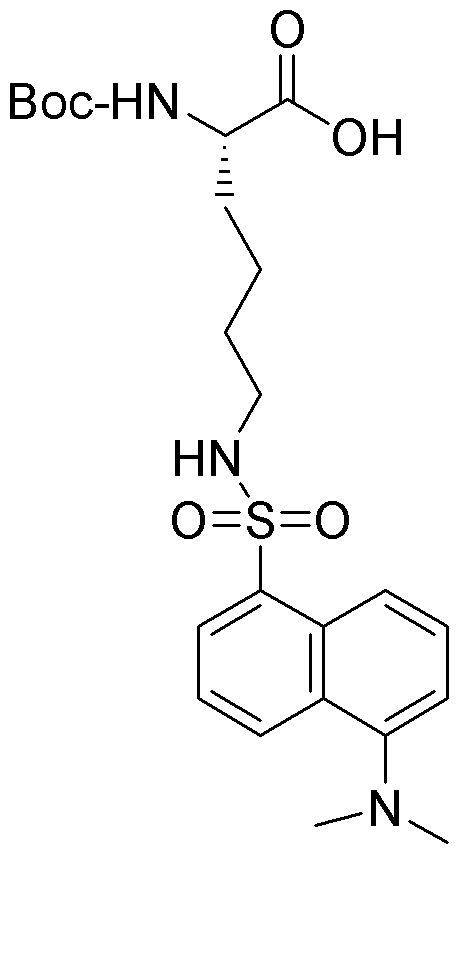Na-Boc-Ne-dansyl-L-lysine is widely utilized in research focused on:
- Fluorescent Labeling: This compound is often used as a fluorescent probe in biochemical assays, allowing researchers to visualize and track proteins or peptides in live cells.
- Peptide Synthesis: It serves as a protective group in the synthesis of peptides, enabling the selective modification of amino acids without affecting the overall structure.
- Drug Development: The compound plays a role in the design of new pharmaceuticals, particularly in targeting specific biological pathways, enhancing drug efficacy and specificity.
- Bioconjugation: It is used in the conjugation of biomolecules, facilitating the attachment of drugs or imaging agents to proteins, which is crucial in targeted therapy and diagnostics.
- Research in Neuroscience: The fluorescent properties make it valuable in studying neuronal pathways and interactions, contributing to advancements in understanding brain functions and disorders.
General Information
Properties
Safety and Regulations
Applications
Na-Boc-Ne-dansyl-L-lysine is widely utilized in research focused on:
- Fluorescent Labeling: This compound is often used as a fluorescent probe in biochemical assays, allowing researchers to visualize and track proteins or peptides in live cells.
- Peptide Synthesis: It serves as a protective group in the synthesis of peptides, enabling the selective modification of amino acids without affecting the overall structure.
- Drug Development: The compound plays a role in the design of new pharmaceuticals, particularly in targeting specific biological pathways, enhancing drug efficacy and specificity.
- Bioconjugation: It is used in the conjugation of biomolecules, facilitating the attachment of drugs or imaging agents to proteins, which is crucial in targeted therapy and diagnostics.
- Research in Neuroscience: The fluorescent properties make it valuable in studying neuronal pathways and interactions, contributing to advancements in understanding brain functions and disorders.
Documents
Safety Data Sheets (SDS)
The SDS provides comprehensive safety information on handling, storage, and disposal of the product.
Product Specification (PS)
The PS provides a comprehensive breakdown of the product’s properties, including chemical composition, physical state, purity, and storage requirements. It also details acceptable quality ranges and the product's intended applications.
Certificates of Analysis (COA)
Search for Certificates of Analysis (COA) by entering the products Lot Number. Lot and Batch Numbers can be found on a product’s label following the words ‘Lot’ or ‘Batch’.
*Catalog Number
*Lot Number
Certificates Of Origin (COO)
This COO confirms the country where the product was manufactured, and also details the materials and components used in it and whether it is derived from natural, synthetic, or other specific sources. This certificate may be required for customs, trade, and regulatory compliance.
*Catalog Number
*Lot Number
Safety Data Sheets (SDS)
The SDS provides comprehensive safety information on handling, storage, and disposal of the product.
DownloadProduct Specification (PS)
The PS provides a comprehensive breakdown of the product’s properties, including chemical composition, physical state, purity, and storage requirements. It also details acceptable quality ranges and the product's intended applications.
DownloadCertificates of Analysis (COA)
Search for Certificates of Analysis (COA) by entering the products Lot Number. Lot and Batch Numbers can be found on a product’s label following the words ‘Lot’ or ‘Batch’.
*Catalog Number
*Lot Number
Certificates Of Origin (COO)
This COO confirms the country where the product was manufactured, and also details the materials and components used in it and whether it is derived from natural, synthetic, or other specific sources. This certificate may be required for customs, trade, and regulatory compliance.


